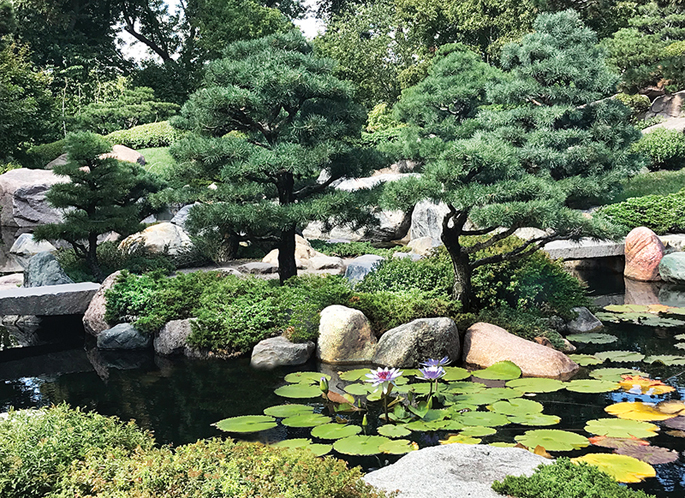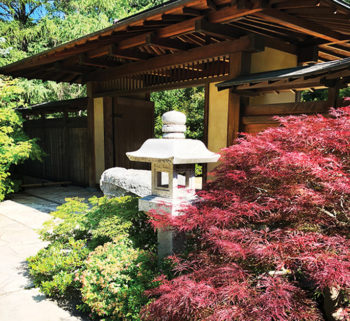
The beauty of water in the wild is unparalleled. Creators of Japanese gardens attempt to capture the brilliance of water and consider how it will ultimately resonate with the viewer.
The Japanese refer to their gardens as Tei-en, which translates as both “wild nature” and “controlled nature,” two opposing characteristics. It is in the exquisite balance of these two fundamental qualities that the Japanese garden finds a universal voice. The early gardens of Japan were not created for aesthetic reasons; instead, they were sacred places meant for prayers and rituals. However, they did contain powerful aesthetic components that would be discovered and brought to the forefront in the future creation of gardens.
My fascination was with an aesthetic that is very close to my own understanding of Tei-en, with Earth serving as the sculpture where the natural world and the sparing hand of human presence mutually create a contemplative environment. Tei-en combined with niwa, the literal translation of “garden,” forms the basic framework for stone, water and plants, the three ingredients for designing a western Japanese garden.
History of Japanese Gardens
Moving through the Japanese garden is a journey, which is also the destination. In a land where space is precious, the art of landscaping and garden design has been taken to very high limits of expression, with distinct formations that engage an aesthetic and philosophy that are completely unique from Western traditions. Rocks and ponds are two of the most fundamental elements of the garden whose use can be traced back to prehistoric times. They are derived from “sacred spaces,” which predate the first gardens by at least 1,000 years.From the grandeur of gardens seen in Han (China), Japanese designers scaled the gardens to fit the topographical and special conditions of Japan. The gardens are smaller, with more concentrated effects that are reduced to the essence of nature. The fundamental relationships and intricacies that exist among water, rocks, trees and sky express themselves in the form of lakes, ponds, rivers, streams and waterfalls.

Early Japanese garden builders also seemed, in my opinion, to be intuitively attuned to the variety of archetypes of the natural landscape. The archetypes are the source images, some say, that reside in our subconscious mind. The well-known garden writer Julie Moir Messervy has identified seven archetypes that, in some way, shape or form, constitute all garden designs and the feelings associated with them, such as the sea (immersing), the cave (nestling), the harbor or cove (embracing), the promontory (extending), the island (separating), the mountains (transforming) and the sky (transcending).
The abundance of water flowing from mountain streams provided clean, clear water for use in ponds. The sites specifically chosen for ponds allow water to flow through, flushing out stagnant contaminants — a cleansing action without using any mechanical means.
This technology utilizes gravity, only knowing that water always flows down hill. Water levels were efficiently controlled through a system of dams and weirs. The garden builders drew upon the technology of wet rice culture, which utilizes the intricate systems of channels for directing water from one growing terrace to another, flowing down the mountain slope.
Movement vs. Stillness
The reflectivity of a still surface draws into view the sky and surrounding landscape, concentric circles from raindrops, wind ripples and small waves, emphasizing the many moods that a pond can present.

All the possible moods of weather effects on water are highly prized when seen from a small pavilion or residence, sheltered in nature, but not of nature. This tension between the natural and human-defined elements seeks to improve the quality of life of the beholder.
Movement and stillness are essential aspects of nature. Out of these two elements, great landscapes were created, tracing back to streams with tributaries, and finally to a mountain spring source. This perspective offers a rich spectrum of design options to scale down into a garden setting.
Such ideas about nature were imported from Han (China) and Korea in a process known as acculturation, where understanding and reinterpretations are tailored to fit the context of the old culture within they are now placed. This gives the indigenous elements of culture new meaning. Imported ideas found a resonant familiarity with the early Japanese garden builders’ ancient animistic perceptions that natural objects — rocks, ponds and islands — are not inanimate, but sacred spirits. Animism is a belief where everything is thought to be alive and thus deeply respected. Perhaps they were some of the first proto-ecologists?
The tradition of the Japanese garden as a seamless progression of accumulated ideas formed over the course of 1,000 years has assumed a refined, understated simplicity, with extraordinary attention to detail and composition. Every part is vital for the creation as a whole, with careful placement of the parts that make up the entirety. Every archetype found in nature can be found somewhere in a Japanese garden.
Japanese Garden Design
I start the design process by making rough concept sketches or 1:1 scale maquettes to flesh out what can and needs to be done. I then roughly quantify what materials and plants will be used and estimate a cost range from the high to low end. This helps determine the size of the garden desired and what kind of resources the client is willing to devote to a project, ultimately giving me direction to proceed.

A large part of the plan is to have a fully disclosed idea of the long-term costs of the garden after it is built. The costs of maintaining a high-quality Japanese garden will exceed the cost of building the garden many times over. Knowing this on the front end determines the affordability scaling and the customer’s commitment to follow through with appropriate maintenance over the years to come. For maintaining a high-quality Japanese garden can be like maintaining a high-end golf course, so proceed with caution!
Occasionally I encounter clients with champagne taste and a beer budget. Building the garden in phases that are broken down into affordable annual amounts, we can build a garden over a period of several years. Longer periods of construction in many cases can allow a customer to evolve into a master plan. This approach requires a great amount of patience.
I take a sculptural approach in creating a garden as it is being built. Remaining open-ended allows for intuitive decisions that are subject to change as construction progresses. This is how an artist brings life to the design of the garden — working up from the details rather than adhering to a master plan. The final plan that ends up on paper ends up being an as-built plan that is completely accurate.
Engineering Simplicity
Building a Japanese garden is an art, a craft and an engineering project. The garden designer must be fluent in all the necessary skills to masterfully make everything work in concert and last at least a generation. Skilled trades are also vital for building beyond the scope of the individual garden designer. The designer functions as a project manager, too, as leader of the team’s progression toward completion.
Assembling high-quality rock often takes time and a keen eye for picking and choosing from a quarry or gravel pit. Unique, beautiful stones need to be avoided, since they call undue attention to themselves. Accessorizing the garden with cultural artifacts also requires a very discriminating eye so that the garden is not overloaded with water basins, stone lanterns, pagodas or statuary of any kind. Less is more in this case. Otherwise, one destroys the simplicity that is vital for a tranquil space.

Plantings are kept to a fairly limited palette of green leaf Japanese maples, flowering cherry, pines, cypresses, azaleas, magnolias, rhododendrons, boxwoods, Japanese yews, ground covers, ferns and several species of mosses. Choosing dwarf plants for the garden only creates a “munchkin garden,” where the only thing missing is a yellow brick road.
Japanese gardens are not very floriferous. The only blossoms tolerated are incidental to the plants themselves and bloom in their own time. The Japanese love flowers but avoid introducing too much color, since the color distracts from the rest of the garden.
The majority of larger gardens are located in the public domain — botanical gardens, arboretums, public parks, private estates, art museums, show gardens at hotels and elegant inns, corporate and foundations grounds, Buddhist Temple compounds and those considered part of the Japanese Imperial House Holdings. Many gardens are designated as important cultural heritage properties by the Japanese government.
Sukiya Gardens
The majority of gardens are residential and thus smaller in size. There are thousands of these throughout Japan, rural and urban, each as unique and as simple as can be imagined. Often these gardens are crafted by a homeowner with occasional guidance from professional gardeners. These small gardens are part of Sukiya-styled architecture, which is Japan’s primary form of residential architecture from the 17th century to present day.

Sukiya living environments, or the combination of a home, its interior spaces and the surrounding garden, are meant to be viewed from inside the building. At the center of this unified property is a graceful, high-quality home that avoids clutter and ostentation. It is visually integrated with exterior spaces. The hallmarks include skilled craftsmanship, the ample use of natural materials, light, elegant proportions and respect for the human scale. The overall mood is one of quiet elegance surrounded by natural beauty, bringing quality to life.
My design practice concentrates on Sukiya gardens, which can be surprisingly very affordable for many homeowners.
There Is a Season
Japanese gardens are created with all four seasons in mind. Each season displays an inherent uniqueness. Spring offers the emerging and awakening delights of running waters, melted ice in ponds, breaking buds and sprouting leaves, blossoming ephemerals and early flowering of the cherry trees. It reminds everyone of the life cycle, always moving on to the next season. Summer brings out the full character of trees and shrubs, followed by autumn and the color changes of leaves in preparation for winter’s dormancy. Pond sizes were designed in a way to maintain even water temperatures by limiting full sun exposure to no more than four to six hours a day.

Though we understand and appreciate the four seasons of the year, there is something very unique acknowledged in Japan that is based on its agricultural roots. In ancient times, the Japanese divided their year into 24 periods based on classical Chinese sources. The year comes to life in the vividly named subdivisions of the Japanese calendar.
There are actually 72 micro-seasons, each lasting approximately five days. Each is also linked with an observation made centuries ago and correlated with subtle changes as each year progresses. This practice was likely started by farmers who accumulated observations made over time. Observations were made, for example, where a certain plant bloomed, when certain birds arrived, when the rice was to be planted, when fruits were to be harvested, when a specific butterfly emerged from its cocoon and so forth. In their present form, they offer a poetic journey through the Japanese year, where land awakens and blooms with life and activity before returning to slumber.
As water shapers, we study the ways of water and ponds. This is vital to understanding how water works to resonate with the garden viewer. It took the Japanese garden builders 1,000 years of trial and error, a skill honed through acute observations made in the wilderness — not in a classroom or book. It must be experienced firsthand to see and understand the ways of water. It is important to remember that the language of the garden is nature.
We struggle and strive over a lifetime to master the skills of pond building, to grasp the essence of nature’s lessons and apply those understandings in creating magnificent waterscapes. As the saying goes, and as we water shapers need to remember, “Do not seek to follow in the footsteps of the Masters. Seek what they sought.”


